INSTITUT SUPERIEUR D'ANTHROPOLOGIE
INSTITUTE OF ANTHROPOLOGY
ONLINE COURSES / COURS A DISTANCE
INSCRIPTIONS OUVERTES
REGISTER NOW
IRAN – 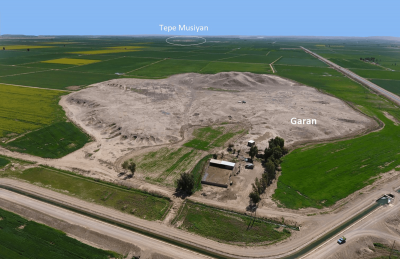
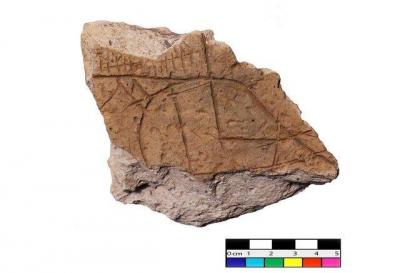 Garan - Archaeologists discovered a brick inscribed with Akkadian script, marking the Elamite water supply system, alongside some intricately patterned bricks in Iran’s Dehloran Valley. This discovery sheds light on the political and economic significance of the ancient site of Garan, located on the western border of Elamite civilization. Tappeh Gārān (locally pronounced Gharrān) is a large mound in the Deh Luran plain, about 3 km east of the Dawairij River and 2.8 km north/northwestern of Tappeh Musiyan. Researchers believe that the written objects found at Gārān consist of Akkadian scripts and geometric patterns thought to illustrate the outlines of an agricultural scheme. During the surface survey on Gārān Mound two inscribed objects were found. The inscriptions yield some information on the economic and political importance of Tappeh Gārān in the Old Elamite Period. “Garan, situated in the Dehloran Valley within the modern province of Ilam and on the southwestern plateau of Iran, covers an area of 17 hectares. It features a prominent cone-shaped elevation in the south of the site, surrounded by several irregular mounds to the east, north, and west of the main prominence,” said Mohsen Zeinivand, an archaeologist involved in the excavation. Regarding recent examinations of the site, Zeinivand explained: “Surface surveys identified numerous broken bricks with possible inscriptions. Although the inscriptions on these brick fragments were not easily decipherable due to weathering and erosion, one sample revealed partially readable words such as ‘ruler,’ ‘son,’ and ‘his lord,’ suggesting Akkadian language.”According to Zeinivand, the lines on the patterned bricks represent four distinct features: a river, a mountain, a dam or embankment, and irrigation channels. In conclusion, the archaeologist emphasized that the Akkadian-inscribed brick, coupled with the patterned ones, likely offers insights into the political and economic significance of Garan on the western borders of ancient Elam.
Garan - Archaeologists discovered a brick inscribed with Akkadian script, marking the Elamite water supply system, alongside some intricately patterned bricks in Iran’s Dehloran Valley. This discovery sheds light on the political and economic significance of the ancient site of Garan, located on the western border of Elamite civilization. Tappeh Gārān (locally pronounced Gharrān) is a large mound in the Deh Luran plain, about 3 km east of the Dawairij River and 2.8 km north/northwestern of Tappeh Musiyan. Researchers believe that the written objects found at Gārān consist of Akkadian scripts and geometric patterns thought to illustrate the outlines of an agricultural scheme. During the surface survey on Gārān Mound two inscribed objects were found. The inscriptions yield some information on the economic and political importance of Tappeh Gārān in the Old Elamite Period. “Garan, situated in the Dehloran Valley within the modern province of Ilam and on the southwestern plateau of Iran, covers an area of 17 hectares. It features a prominent cone-shaped elevation in the south of the site, surrounded by several irregular mounds to the east, north, and west of the main prominence,” said Mohsen Zeinivand, an archaeologist involved in the excavation. Regarding recent examinations of the site, Zeinivand explained: “Surface surveys identified numerous broken bricks with possible inscriptions. Although the inscriptions on these brick fragments were not easily decipherable due to weathering and erosion, one sample revealed partially readable words such as ‘ruler,’ ‘son,’ and ‘his lord,’ suggesting Akkadian language.”According to Zeinivand, the lines on the patterned bricks represent four distinct features: a river, a mountain, a dam or embankment, and irrigation channels. In conclusion, the archaeologist emphasized that the Akkadian-inscribed brick, coupled with the patterned ones, likely offers insights into the political and economic significance of Garan on the western borders of ancient Elam.
https://arkeonews.net/newly-discovered-inscribed-brick-may-reveal-elamite-water-supply-system-in-western-iran/
ITALIE – 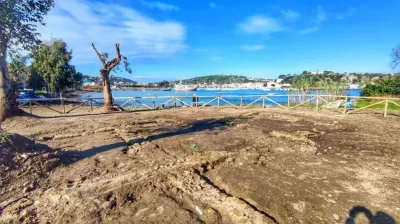 Miseno - Archaeologists have uncovered a Roman villa complex on the shoreline of Miseno in the northwestern end of the Bay of Naples. During the Roman period, Miseno was a large port known as Misenum (named after Misenus, a companion of Hector and trumpeter to Aeneas), later serving as the primary port for the Classis Misenensis, the senior fleet of the imperial Roman navy. It was from here that Pliny the Elder (the author of the encyclopedic Naturalis Historia) was the praefect in charge of the naval fleet at the time of the eruption of Mount Vesuvius in AD 79. Pliny organised and led a rescue mission across the bay, yet tragically succumbed to asphyxiation resulting from the noxious gases emitted by the volcano. Recent excavations at Miseno have uncovered a villa complex dated to the 1st century AD during the period of the eruption, which according to the archaeologists may have been the residence of Pliny the Elder, however, at this time this is merely conjecture. The villa consists of 10 large rooms dated to different periods of construction, and has opus reticulatum walls – a form of Roman brickwork consisting of diamond-shaped bricks of tuff referred to as cubilia.,The complex extends from the shore without interruption to the beach, with parts now becoming partially submerged likely due to local volcanic bradyseismic activity that has raised or lowered the geology on the peninsula.
Miseno - Archaeologists have uncovered a Roman villa complex on the shoreline of Miseno in the northwestern end of the Bay of Naples. During the Roman period, Miseno was a large port known as Misenum (named after Misenus, a companion of Hector and trumpeter to Aeneas), later serving as the primary port for the Classis Misenensis, the senior fleet of the imperial Roman navy. It was from here that Pliny the Elder (the author of the encyclopedic Naturalis Historia) was the praefect in charge of the naval fleet at the time of the eruption of Mount Vesuvius in AD 79. Pliny organised and led a rescue mission across the bay, yet tragically succumbed to asphyxiation resulting from the noxious gases emitted by the volcano. Recent excavations at Miseno have uncovered a villa complex dated to the 1st century AD during the period of the eruption, which according to the archaeologists may have been the residence of Pliny the Elder, however, at this time this is merely conjecture. The villa consists of 10 large rooms dated to different periods of construction, and has opus reticulatum walls – a form of Roman brickwork consisting of diamond-shaped bricks of tuff referred to as cubilia.,The complex extends from the shore without interruption to the beach, with parts now becoming partially submerged likely due to local volcanic bradyseismic activity that has raised or lowered the geology on the peninsula.
https://www.heritagedaily.com/2024/01/roman-villa-complex-found-at-miseno/150244
GRECE – 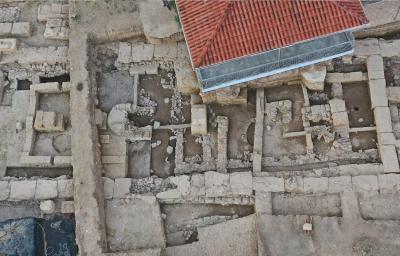
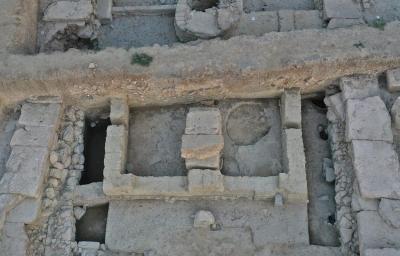
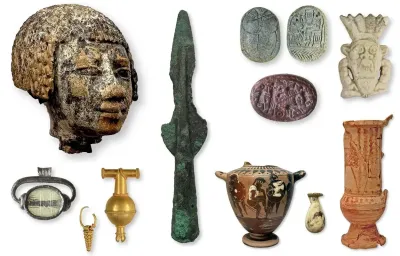 Euboca - Archaeologists excavating a temple complex at the Artemis Amarynthos sanctuary have uncovered evidence of animal sacrificial rites and new insights into the temple configuration.The Artemis Amarynthos sanctuary is located in Amarynthos on the Greek island of Euboea. During antiquity, the sanctuary was the centre of worship in dedication to Artemis (the goddess of the hunt, wild animals, and nature) in Northern Greece, and served as the annual pilgrimage destination from Eretria during the Amarysia festival procession. Excavations at the sanctuary have been ongoing for the past four years, with this season’s dig uncovering further remains of a temple dated to the 7th century BC during the Archaic Period. According to the researchers, the temple has an apsidal floor plan and measures 34 metres in length, which coincidentally corresponds to 100 feet in the Greek metric system. Archaeologists found hearths or altars where animals were sacrificed to honour Artemis, in addition to layers of ash and calcined animal bones. In traditional animal sacrifices, the animal was led in procession to the altar and slaughtered. The carcass would then be butchered and the internal organs, bones and other inedible parts burnt as the deity’s portion. Excavations also found a large number of offerings consisting of vases, weapons, jewellery, and a finely chiseled ivory head with Egyptian features. Evidence of burning indicates that the temple was partially destroyed by fire during the 6th century BC but was restored with mud-brick walls, before being entirely demolished for a new structure by the end of the century. Deep trial trenches also uncovered a building from the 9th or 8th century BC, in addition to bronze animal figurines and a terracotta bull’s head from the late Bronze Age, suggesting that the site held ceremonial significance dating back to prehistoric times.
Euboca - Archaeologists excavating a temple complex at the Artemis Amarynthos sanctuary have uncovered evidence of animal sacrificial rites and new insights into the temple configuration.The Artemis Amarynthos sanctuary is located in Amarynthos on the Greek island of Euboea. During antiquity, the sanctuary was the centre of worship in dedication to Artemis (the goddess of the hunt, wild animals, and nature) in Northern Greece, and served as the annual pilgrimage destination from Eretria during the Amarysia festival procession. Excavations at the sanctuary have been ongoing for the past four years, with this season’s dig uncovering further remains of a temple dated to the 7th century BC during the Archaic Period. According to the researchers, the temple has an apsidal floor plan and measures 34 metres in length, which coincidentally corresponds to 100 feet in the Greek metric system. Archaeologists found hearths or altars where animals were sacrificed to honour Artemis, in addition to layers of ash and calcined animal bones. In traditional animal sacrifices, the animal was led in procession to the altar and slaughtered. The carcass would then be butchered and the internal organs, bones and other inedible parts burnt as the deity’s portion. Excavations also found a large number of offerings consisting of vases, weapons, jewellery, and a finely chiseled ivory head with Egyptian features. Evidence of burning indicates that the temple was partially destroyed by fire during the 6th century BC but was restored with mud-brick walls, before being entirely demolished for a new structure by the end of the century. Deep trial trenches also uncovered a building from the 9th or 8th century BC, in addition to bronze animal figurines and a terracotta bull’s head from the late Bronze Age, suggesting that the site held ceremonial significance dating back to prehistoric times.
https://www.heritagedaily.com/2024/01/excavation-of-artemis-temple-reveals-evidence-of-animal-sacrifices/150230
FRANCE - 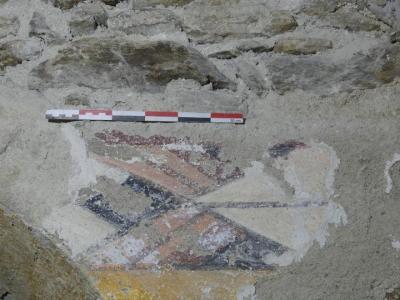 Sainte-Croix-en-Jarez - Les archéologues de l’Inrap ont mené une fouille sur les élévations intérieures et extérieures de l’église médiévale de l’ancienne chartreuse de Sainte-Croix-en-Jarez, en accompagnement du projet de restauration porté par la commune. Elle a permis de mieux appréhender les évolutions architecturales, liturgiques et décoratives du bâtiment entre la fin du XIIIe siècle et le XVIIIe siècle. Un premier bâtiment, orienté nord-est/sud-ouest, a été reconnu dans les élévations de l’ancienne église médiévale. Arasé, il est conservé sur environ 12,30 m de long, mesure 8 m de large et a été reconnu sur une hauteur maximale de 3 m. Les données sur ce bâtiment montrent un ouvrage cohérent et soigné. Ce dernier a conservé ses structures d’origine. Deux baies monumentales témoignent d’un dispositif d’éclairage direct, depuis le nord. Deux portes, la première à l’est, la seconde au sud, nous permettent de restituer un niveau de circulation qui s’adapte aux dénivellations du rocher.,Si son identification, comme première église de la chartreuse, reste difficile à affirmer, l’attribution de ce bâtiment à la fin du XIIIe siècle est possible grâce aux sources archivistiques et grâce aux données archéométriques (dendrochronologie).Les études précédentes ont questionné l’homogénéité architecturale de l’église du XIVe siècle. Dans le cadre de cette opération, plusieurs phases de constructions ont clairement été reconnues. Ces travaux d’aménagement et de transformation ont dû être réalisés dans un laps de temps très court, avec cependant à chaque fois un soin réel apporté aux accès, aux dispositifs d’éclairages, aux aménagements liturgiques et aux décors peints. La première phase de construction correspond à l’édification d’une vaste nef quadrangulaire, d’environ 100 m2, délimitée à l’est par un arc triomphal en pierre de taille et éclairée depuis le nord par plusieurs fenêtres construites en briques. Un niveau de plancher peut être restitué sur toute la surface de cette nef, grâce à la découverte de plusieurs négatifs de poutre. Ce plancher est associé à un massif maçonné, identifié comme le soubassement d’une potentielle porte. Cet accès est situé à l’aplomb de l’arc triomphal. La seconde phase de construction correspond à l’élévation du chœur sur un soubassement monumental. Cette travée de chœur mesure 7,80 m de long et 6,50 m de large. Elle est éclairée depuis le nord et depuis l’est par des baies élevées en pierre de taille (grès). Ce chœur, couvert d’une voûte d’ogive, est construit en appui contre l’arc triomphal et contre les élévations de la nef. À la jonction de ces deux espaces, un contrefort monumental extérieur conforte le bâtiment. Plusieurs aménagements, contemporains du chœur, sont réalisés sur les élévations de la nef. Le dispositif d’éclairage d’origine est abandonné. Deux fenêtres monumentales en pierre de taille sont alors insérées au centre des murs nord et sud du bâtiment, tandis qu’une baie est ouverte en façade occidentale. Les accès au bâtiment sont aménagés dans le mur gouttereau sud. La nef est couverte d’une charpente diaphragme. En effet, plusieurs négatifs de jambe de force maintenant les fermes d’une charpente ont été reconnus. Ce décor est surmonté d’une frise géométrique. Cette frise court sur les murs jusqu’à l’encadrement intérieur des fenêtres. Ces dernières sont alors mises en valeur par un second faux appareil ocre-jaune et rouge. Ce décor est contemporain d’une tribune et de stalles aujourd’hui perçues en négatif grâce à plusieurs arrêts nets du décor peint, mais aussi grâce à des points d’accroches et la présence de massifs de fondations. Dans le nouveau sanctuaire, des peintures figuratives délimitent la sépulture de Thibaud de Vassalieu, grand bienfaiteur de la chartreuse. Associées à un négatif de plate tombe, elles sont isolées du reste des décors peints par une succession de bandeaux rouge et jaune. Cette mise en valeur permet ainsi de différencier et d’équilibrer l’espace dédié à l’inhumation et l’espace de célébration qui est de sanctuaire.
Sainte-Croix-en-Jarez - Les archéologues de l’Inrap ont mené une fouille sur les élévations intérieures et extérieures de l’église médiévale de l’ancienne chartreuse de Sainte-Croix-en-Jarez, en accompagnement du projet de restauration porté par la commune. Elle a permis de mieux appréhender les évolutions architecturales, liturgiques et décoratives du bâtiment entre la fin du XIIIe siècle et le XVIIIe siècle. Un premier bâtiment, orienté nord-est/sud-ouest, a été reconnu dans les élévations de l’ancienne église médiévale. Arasé, il est conservé sur environ 12,30 m de long, mesure 8 m de large et a été reconnu sur une hauteur maximale de 3 m. Les données sur ce bâtiment montrent un ouvrage cohérent et soigné. Ce dernier a conservé ses structures d’origine. Deux baies monumentales témoignent d’un dispositif d’éclairage direct, depuis le nord. Deux portes, la première à l’est, la seconde au sud, nous permettent de restituer un niveau de circulation qui s’adapte aux dénivellations du rocher.,Si son identification, comme première église de la chartreuse, reste difficile à affirmer, l’attribution de ce bâtiment à la fin du XIIIe siècle est possible grâce aux sources archivistiques et grâce aux données archéométriques (dendrochronologie).Les études précédentes ont questionné l’homogénéité architecturale de l’église du XIVe siècle. Dans le cadre de cette opération, plusieurs phases de constructions ont clairement été reconnues. Ces travaux d’aménagement et de transformation ont dû être réalisés dans un laps de temps très court, avec cependant à chaque fois un soin réel apporté aux accès, aux dispositifs d’éclairages, aux aménagements liturgiques et aux décors peints. La première phase de construction correspond à l’édification d’une vaste nef quadrangulaire, d’environ 100 m2, délimitée à l’est par un arc triomphal en pierre de taille et éclairée depuis le nord par plusieurs fenêtres construites en briques. Un niveau de plancher peut être restitué sur toute la surface de cette nef, grâce à la découverte de plusieurs négatifs de poutre. Ce plancher est associé à un massif maçonné, identifié comme le soubassement d’une potentielle porte. Cet accès est situé à l’aplomb de l’arc triomphal. La seconde phase de construction correspond à l’élévation du chœur sur un soubassement monumental. Cette travée de chœur mesure 7,80 m de long et 6,50 m de large. Elle est éclairée depuis le nord et depuis l’est par des baies élevées en pierre de taille (grès). Ce chœur, couvert d’une voûte d’ogive, est construit en appui contre l’arc triomphal et contre les élévations de la nef. À la jonction de ces deux espaces, un contrefort monumental extérieur conforte le bâtiment. Plusieurs aménagements, contemporains du chœur, sont réalisés sur les élévations de la nef. Le dispositif d’éclairage d’origine est abandonné. Deux fenêtres monumentales en pierre de taille sont alors insérées au centre des murs nord et sud du bâtiment, tandis qu’une baie est ouverte en façade occidentale. Les accès au bâtiment sont aménagés dans le mur gouttereau sud. La nef est couverte d’une charpente diaphragme. En effet, plusieurs négatifs de jambe de force maintenant les fermes d’une charpente ont été reconnus. Ce décor est surmonté d’une frise géométrique. Cette frise court sur les murs jusqu’à l’encadrement intérieur des fenêtres. Ces dernières sont alors mises en valeur par un second faux appareil ocre-jaune et rouge. Ce décor est contemporain d’une tribune et de stalles aujourd’hui perçues en négatif grâce à plusieurs arrêts nets du décor peint, mais aussi grâce à des points d’accroches et la présence de massifs de fondations. Dans le nouveau sanctuaire, des peintures figuratives délimitent la sépulture de Thibaud de Vassalieu, grand bienfaiteur de la chartreuse. Associées à un négatif de plate tombe, elles sont isolées du reste des décors peints par une succession de bandeaux rouge et jaune. Cette mise en valeur permet ainsi de différencier et d’équilibrer l’espace dédié à l’inhumation et l’espace de célébration qui est de sanctuaire.
https://www.inrap.fr/l-eglise-medievale-de-sainte-croix-en-jarez-loire-17723
ITALIE – 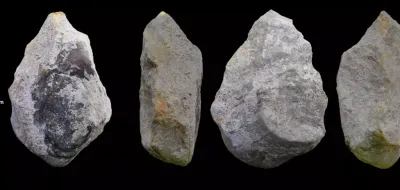 Notarchirico - Les données récentes montrent que l’Europe de l’Ouest est peuplée vers 1,2-1,4 millions d’années. Puis vers 700 000 ans arrivent de nouveaux groupes humains avec de nouveaux outillages comme les bifaces que l’on attribue à l’Acheuléen. Ces nouveaux occupants sont décrits sous le terme d’Homo heidelbergensis et restent encore énigmatiques. Ils semblent s’adapter à des environnements plus variés avec des outillages plus complexes. Ils peuplent en continu le sud de l’Europe alors que le nord-ouest est dépeuplé pendant les périodes glaciaires. Le site de Notarchirico livre plus de 10 phases d’occupation couvrant un interglaciaire et un glaciaire. Il permet de décrire les comportements des hominidés vivant dans le sud de l’Europe et les comparer à ceux vivant dans les latitudes plus septentrionales.
Notarchirico - Les données récentes montrent que l’Europe de l’Ouest est peuplée vers 1,2-1,4 millions d’années. Puis vers 700 000 ans arrivent de nouveaux groupes humains avec de nouveaux outillages comme les bifaces que l’on attribue à l’Acheuléen. Ces nouveaux occupants sont décrits sous le terme d’Homo heidelbergensis et restent encore énigmatiques. Ils semblent s’adapter à des environnements plus variés avec des outillages plus complexes. Ils peuplent en continu le sud de l’Europe alors que le nord-ouest est dépeuplé pendant les périodes glaciaires. Le site de Notarchirico livre plus de 10 phases d’occupation couvrant un interglaciaire et un glaciaire. Il permet de décrire les comportements des hominidés vivant dans le sud de l’Europe et les comparer à ceux vivant dans les latitudes plus septentrionales.
https://www.hominides.com/premier-peuplement-europe-et-arrivee-homo-heidelbergensis/
AFGHANISTAN – 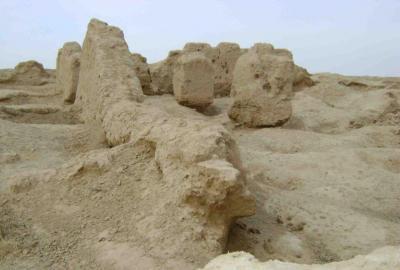 -Jawzjan, - The technical team of the Department of Archeology of the ministry discovered 15 historical sites in the districts of Khoja Dokuh, Faiz Abad and Sheberghan, according to the statement. “During the research also pottery, beads and a coin have been discovered, which dating back to the 2nd to the 13th century,” the statement quoted Mawlavi Mutassim as saying. Mawlavi Mutassim added that 43 historical sites have been registered in Jawzjan province, and with the identification of 15 historical sites, the number reaches 58 sites.
-Jawzjan, - The technical team of the Department of Archeology of the ministry discovered 15 historical sites in the districts of Khoja Dokuh, Faiz Abad and Sheberghan, according to the statement. “During the research also pottery, beads and a coin have been discovered, which dating back to the 2nd to the 13th century,” the statement quoted Mawlavi Mutassim as saying. Mawlavi Mutassim added that 43 historical sites have been registered in Jawzjan province, and with the identification of 15 historical sites, the number reaches 58 sites.
https://thekabultimes.com/15-historical-sites-recovered-in-jawzjan/
CHINE - Shandong - total of 301 ancient tombs were recently unearthed in east China's Shandong Province, according to the Archaeology Institute of Jinan. The tombs, which span from the Warring States period (475-221 BC) to the Qing Dynasty (1644-1911), were discovered in Jinan City, capital of Shandong Province. In addition to tombs, other ruins including two kiln sites, three ash pits, and eight wells, were also excavated. From these sites, 850 sets of artifacts, including clay pots, ceramic plates, and copper coins, were unearthed.;According to the institute, the tombs were distributed and arranged in an orderly manner, and one of the tomb cemeteries, which dates back to the Warring States Period to the Wei and Jin dynasties (220-420), was probably in use for hundreds of years, providing tomb development materials for research.
https://english.news.cn/20240115/1d439c84d192481d9db19e415f8cb24a/c.html
ITALIE 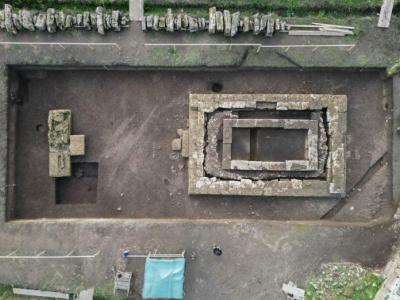 Paestum - Two Ancient Greek Doric temples were unearthed in Paestum, southern Italy. The temples were part of the Magna Graecia (Great Greece), the thriving group of ancient Greek cities of southern Italy dating back from the 8th century BC. One of the major cities of Magna Graecia was the location of the temples unearthed. The ancient city of Poseidonia-Paestum of Southern Italy has been a subject of much intrigue for historians and archaeologists alike. In the western part of Poseidonia-Paestum, near the city walls and a few hundred meters from the sea, a stratigraphic excavation campaign is underway. This significant archaeological endeavor has brought to light two Doric-style Greek temples. These sacred buildings allow for new insights into the origins and urban development of the Magna Graecia polis. They provide crucial data for understanding the evolution of Doric architecture in Poseidonia and Magna Graecia. The first temple, initially intercepted in June 2019 and investigated from September 2022, dates back to the early decades of the 5th century BC. It stands unique in its architectural characteristics and dimensions, representing a singular entity in Doric temple architecture. Preserved are parts of the stylobate (column base) and the crepidoma (steps where the temple was built), measuring 11.60 x 7.60 m, with a peristasis of 4×6 columns. Recent investigations reveal a more ancient story for the sanctuary. Within the temple structure, beneath the peristasis, 14 fragmentary Doric capitals and other architectural materials have been repurposed, likely for ritualistic purposes. These capitals are similar in size to those of the smaller temple explored so far. However, their typology is different, comparable to the capitals of the Temple of Hera I, also known as the “Basilica,” the oldest of Paestum’s three major temples. These exceptional findings suggest the presence of another temple, modest in size but with architectural features similar to those of the first great temples of Paestum, dating back to the 6th century BC. For reasons yet to be determined, perhaps a collapse, this structure was replaced in the same area by a new temple at the beginning of the following century. This finding is extremely important as it documents that at the end of the 6th century BC, when the oldest temple was erected, the city of Poseidonia was not yet equipped with defensive walls. During a period of significant growth of the polis, the colonists of Poseidonia built a sanctuary in a strategic location. It protected the urban space and was directly visible from the sea. The importance of this sacred space is confirmed by its complex building phases, which saw the construction of two Doric temples. Its uninterrupted use, spanning over half a millennium, marks a fundamental continuity of worship through the Greco-Lucanian and Roman eras.
Paestum - Two Ancient Greek Doric temples were unearthed in Paestum, southern Italy. The temples were part of the Magna Graecia (Great Greece), the thriving group of ancient Greek cities of southern Italy dating back from the 8th century BC. One of the major cities of Magna Graecia was the location of the temples unearthed. The ancient city of Poseidonia-Paestum of Southern Italy has been a subject of much intrigue for historians and archaeologists alike. In the western part of Poseidonia-Paestum, near the city walls and a few hundred meters from the sea, a stratigraphic excavation campaign is underway. This significant archaeological endeavor has brought to light two Doric-style Greek temples. These sacred buildings allow for new insights into the origins and urban development of the Magna Graecia polis. They provide crucial data for understanding the evolution of Doric architecture in Poseidonia and Magna Graecia. The first temple, initially intercepted in June 2019 and investigated from September 2022, dates back to the early decades of the 5th century BC. It stands unique in its architectural characteristics and dimensions, representing a singular entity in Doric temple architecture. Preserved are parts of the stylobate (column base) and the crepidoma (steps where the temple was built), measuring 11.60 x 7.60 m, with a peristasis of 4×6 columns. Recent investigations reveal a more ancient story for the sanctuary. Within the temple structure, beneath the peristasis, 14 fragmentary Doric capitals and other architectural materials have been repurposed, likely for ritualistic purposes. These capitals are similar in size to those of the smaller temple explored so far. However, their typology is different, comparable to the capitals of the Temple of Hera I, also known as the “Basilica,” the oldest of Paestum’s three major temples. These exceptional findings suggest the presence of another temple, modest in size but with architectural features similar to those of the first great temples of Paestum, dating back to the 6th century BC. For reasons yet to be determined, perhaps a collapse, this structure was replaced in the same area by a new temple at the beginning of the following century. This finding is extremely important as it documents that at the end of the 6th century BC, when the oldest temple was erected, the city of Poseidonia was not yet equipped with defensive walls. During a period of significant growth of the polis, the colonists of Poseidonia built a sanctuary in a strategic location. It protected the urban space and was directly visible from the sea. The importance of this sacred space is confirmed by its complex building phases, which saw the construction of two Doric temples. Its uninterrupted use, spanning over half a millennium, marks a fundamental continuity of worship through the Greco-Lucanian and Roman eras.
https://greekreporter.com/2024/01/14/ancient-greek-temples-paestum-italy/